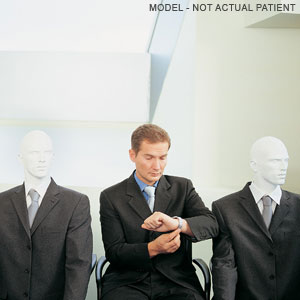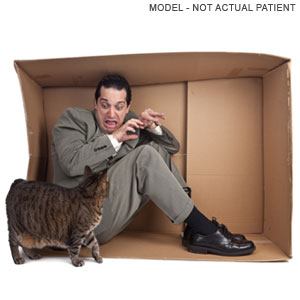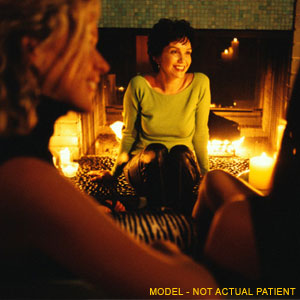Select Language - [Espanol]

3605 Long Beach Blvd., Suite 100
Long Beach, CA 90807
Phone: 562.981.2200
Anxiety Disorders affect about 40 million American adults age 18 years and older (about 18%) in a given year,¹ causing them to be filled with fearfulness and uncertainty. Unlike the relatively mild, brief anxiety caused by a stressful event (such as speaking in public or a first date), anxiety disorders last at least 6 months and can get worse if they are not treated. Anxiety disorders commonly occur along with other mental or physical illnesses, including alcohol or substance abuse, which may mask anxiety symptoms or make them worse. In some cases, these other illnesses need to be treated before a person will respond to treatment for the anxiety disorder.
Effective therapies for anxiety disorders are available, and research is uncovering new treatments that can help most people with anxiety disorders lead productive, fulfilling lives. If you think you have an anxiety disorder, you should seek information and treatment right away.

Panic disorder is a real illness that can be successfully treated. It is characterized by sudden attacks of terror, usually accompanied by a pounding heart, sweatiness, weakness, faintness, or dizziness. During these attacks, people with panic disorder may flush or feel chilled; their hands may tingle or feel numb; and they may experience nausea, chest pain, or smothering sensations. Panic attacks usually produce a sense of unreality, a fear of impending doom, or a fear of losing control.
A fear of one’s own unexplained physical symptoms is also a symptom of panic disorder. People having panic attacks sometimes believe they are having heart attacks, losing their minds, or on the verge of death. They can’t predict when or where an attack will occur, and between episodes many worry intensely and dread the next attack.
Panic attacks can occur at any time, even during sleep. An attack usually peaks within 10 minutes, but some symptoms may last much longer.
Panic disorder affects about 6 million American adults1 and is twice as common in women as men.² Panic attacks often begin in late adolescence or early adulthood,2 but not everyone who experiences panic attacks will develop panic disorder. Many people have just one attack and never have another. The tendency to develop panic attacks appears to be inherited.³
People who have full-blown, repeated panic attacks can become very disabled by their condition and should seek treatment before they start to avoid places or situations where panic attacks have occurred. For example, if a panic attack happened in an elevator, someone with panic disorder may develop a fear of elevators that could affect the choice of a job or an apartment, and restrict where that person can seek medical attention or enjoy entertainment.
Some people’s lives become so restricted that they avoid normal activities, such as grocery shopping or driving. About one-third become housebound or are able to confront a feared situation only when accompanied by a spouse or other trusted person.² When the condition progresses this far, it is called agoraphobia, or fear of open spaces.
Early treatment can often prevent agoraphobia, but people with panic disorder may sometimes go from doctor to doctor for years and visit the emergency room repeatedly before someone correctly diagnoses their condition. This is unfortunate, because panic disorder is one of the most treatable of all the anxiety disorders, responding in most cases to certain kinds of medication or certain kinds of cognitive psychotherapy, which help change thinking patterns that lead to fear and anxiety.
Panic disorder is often accompanied by other serious problems, such as depression, drug abuse, or alcoholism.4,5 These conditions need to be treated separately. Symptoms of depression include feelings of sadness or hopelessness, changes in appetite or sleep patterns, low energy, and difficulty concentrating. Most people with depression can be effectively treated with antidepressant medications, certain types of psychotherapy, or a combination of the two.

People with obsessive-compulsive disorder (OCD) have persistent, upsetting thoughts (obsessions) and use rituals (compulsions) to control the anxiety these thoughts produce. Most of the time, the rituals end up controlling them.
For example, if people are obsessed with germs or dirt, they may develop a compulsion to wash their hands over and over again. If they develop an obsession with intruders, they may lock and relock their doors many times before going to bed. Being afraid of social embarrassment may prompt people with OCD to comb their hair compulsively in front of a mirror-sometimes they get “caught” in the mirror and can’t move away from it. Performing such rituals is not pleasurable. At best, it produces temporary relief from the anxiety created by obsessive thoughts.
Other common rituals are a need to repeatedly check things, touch things (especially in a particular sequence), or count things. Some common obsessions include having frequent thoughts of violence and harming loved ones, persistently thinking about performing sexual acts the person dislikes, or having thoughts that are prohibited by religious beliefs. People with OCD may also be preoccupied with order and symmetry, have difficulty throwing things out (so they accumulate), or hoard unneeded items.
Healthy people also have rituals, such as checking to see if the stove is off several times before leaving the house. The difference is that people with OCD perform their rituals even though doing so interferes with daily life and they find the repetition distressing. Although most adults with OCD recognize that what they are doing is senseless, some adults and most children may not realize that their behavior is out of the ordinary.
OCD affects about 2.2 million American adults,¹ and the problem can be accompanied by eating disorders,6 other anxiety disorders, or depression.2,4 It strikes men and women in roughly equal numbers and usually appears in childhood, adolescence, or early adulthood.² One-third of adults with OCD develop symptoms as children, and research indicates that OCD might run in families.³
The course of the disease is quite varied. Symptoms may come and go, ease over time, or get worse. If OCD becomes severe, it can keep a person from working or carrying out normal responsibilities at home. People with OCD may try to help themselves by avoiding situations that trigger their obsessions, or they may use alcohol or drugs to calm themselves.4,5
OCD usually responds well to treatment with certain medications and/or exposure-based psychotherapy, in which people face situations that cause fear or anxiety and become less sensitive (desensitized) to them.

Post-traumatic stress disorder (PTSD) develops after a terrifying ordeal that involved physical harm or the threat of physical harm. The person who develops PTSD may have been the one who was harmed, the harm may have happened to a loved one, or the person may have witnessed a harmful event that happened to loved ones or strangers.
PTSD was first brought to public attention in relation to war veterans, but it can result from a variety of traumatic incidents, such as mugging, rape, torture, being kidnapped or held captive, child abuse, car accidents, train wrecks, plane crashes, bombings, or natural disasters such as floods or earthquakes.
People with PTSD may startle easily, become emotionally numb (especially in relation to people with whom they used to be close), lose interest in things they used to enjoy, have trouble feeling affectionate, be irritable, become more aggressive, or even become violent. They avoid situations that remind them of the original incident, and anniversaries of the incident are often very difficult. PTSD symptoms seem to be worse if the event that triggered them was deliberately initiated by another person, as in a mugging or a kidnapping.
Most people with PTSD repeatedly relive the trauma in their thoughts during the day and in nightmares when they sleep. These are called flashbacks. Flashbacks may consist of images, sounds, smells, or feelings, and are often triggered by ordinary occurrences, such as a door slamming or a car backfiring on the street. A person having a flashback may lose touch with reality and believe that the traumatic incident is happening all over again.
Not every traumatized person develops full-blown or even minor PTSD. Symptoms usually begin within 3 months of the incident but occasionally emerge years afterward. They must last more than a month to be considered PTSD. The course of the illness varies. Some people recover within 6 months, while others have symptoms that last much longer. In some people, the condition becomes chronic.
PTSD affects about 7.7 million American adults,¹ but it can occur at any age, including childhood.7 Women are more likely to develop PTSD than men,8 and there is some evidence that susceptibility to the disorder may run in families.9 PTSD is often accompanied by depression, substance abuse, or one or more of the other anxiety disorders.4
Certain kinds of medication and certain kinds of psychotherapy usually treat the symptoms of PTSD very effectively.

Social phobia, also called social anxiety disorder, is diagnosed when people become overwhelmingly anxious and excessively self-conscious in everyday social situations. People with social phobia have an intense, persistent, and chronic fear of being watched and judged by others and of doing things that will embarrass them. They can worry for days or weeks before a dreaded situation. This fear may become so severe that it interferes with work, school, and other ordinary activities, and can make it hard to make and keep friends.
While many people with social phobia realize that their fears about being with people are excessive or unreasonable, they are unable to overcome them. Even if they manage to confront their fears and be around others, they are usually very anxious beforehand, are intensely uncomfortable throughout the encounter, and worry about how they were judged for hours afterward.
Social phobia can be limited to one situation (such as talking to people, eating or drinking, or writing on a blackboard in front of others) or may be so broad (such as in generalized social phobia) that the person experiences anxiety around almost anyone other than the family.
Physical symptoms that often accompany social phobia include blushing, profuse sweating, trembling, nausea, and difficulty talking. When these symptoms occur, people with social phobia feel as though all eyes are focused on them.
Social phobia affects about 15 million American adults.¹ Women and men are equally likely to develop the disorder,10 which usually begins in childhood or early adolescence.² There is some evidence that genetic factors are involved.11 Social phobia is often accompanied by other anxiety disorders or depression,2,4 and substance abuse may develop if people try to self-medicate their anxiety.4,5
Social phobia can be successfully treated with certain kinds of psychotherapy or medications.

A specific phobia is an intense, irrational fear of something that poses little or no actual danger. Some of the more common specific phobias are centered around closed-in places, heights, escalators, tunnels, highway driving, water, flying, dogs, and injuries involving blood. Such phobias aren’t just extreme fear; they are irrational fear of a particular thing. You may be able to ski the world’s tallest mountains with ease but be unable to go above the 5th floor of an office building. While adults with phobias realize that these fears are irrational, they often find that facing, or even thinking about facing, the feared object or situation brings on a panic attack or severe anxiety.
Specific phobias affect an estimated 19.2 million adult Americans¹ and are twice as common in women as men.10 They usually appear in childhood or adolescence and tend to persist into adulthood.12 The causes of specific phobias are not well understood, but there is some evidence that the tendency to develop them may run in families.11
If the feared situation or feared object is easy to avoid, people with specific phobias may not seek help; but if avoidance interferes with their careers or their personal lives, it can become disabling and treatment is usually pursued.
Specific phobias respond very well to carefully targeted psychotherapy.

People with generalized anxiety disorder (GAD) go through the day filled with exaggerated worry and tension, even though there is little or nothing to provoke it. They anticipate disaster and are overly concerned about health issues, money, family problems, or difficulties at work. Sometimes just the thought of getting through the day produces anxiety.
GAD is diagnosed when a person worries excessively about a variety of everyday problems for at least 6 months.13 People with GAD can’t seem to get rid of their concerns, even though they usually realize that their anxiety is more intense than the situation warrants. They can’t relax, startle easily, and have difficulty concentrating. Often they have trouble falling asleep or staying asleep. Physical symptoms that often accompany the anxiety include fatigue, headaches, muscle tension, muscle aches, difficulty swallowing, trembling, twitching, irritability, sweating, nausea, lightheadedness, having to go to the bathroom frequently, feeling out of breath, and hot flashes.
When their anxiety level is mild, people with GAD can function socially and hold down a job. Although they don’t avoid certain situations as a result of their disorder, people with GAD can have difficulty carrying out the simplest daily activities if their anxiety is severe.
GAD affects about 6.8 million American adults,¹ including twice as many women as men.² The disorder develops gradually and can begin at any point in the life cycle, although the years of highest risk are between childhood and middle age.² There is evidence that genes play a modest role in GAD.13
Other anxiety disorders, depression, or substance abuse2,4 often accompany GAD, which rarely occurs alone. GAD is commonly treated with medication or cognitive-behavioral therapy, but co-occurring conditions must also be treated using the appropriate therapies.
In general, anxiety disorders are treated with medication, specific types of psychotherapy, or both.14 Treatment choices depend on the problem and the person’s preference. Before treatment begins, a doctor must conduct a careful diagnostic evaluation to determine whether a person’s symptoms are caused by an anxiety disorder or a physical problem. If an anxiety disorder is diagnosed, the type of disorder or the combination of disorders that are present must be identified, as well as any coexisting conditions, such as depression or substance abuse. Sometimes alcoholism, depression, or other coexisting conditions have such a strong effect on the individual that treating the anxiety disorder must wait until the coexisting conditions are brought under control.
People with anxiety disorders who have already received treatment should tell their current doctor about that treatment in detail. If they received medication, they should tell their doctor what medication was used, what the dosage was at the beginning of treatment, whether the dosage was increased or decreased while they were under treatment, what side effects occurred, and whether the treatment helped them become less anxious. If they received psychotherapy, they should describe the type of therapy, how often they attended sessions, and whether the therapy was useful.
Often people believe that they have “failed” at treatment or that the treatment didn’t work for them when, in fact, it was not given for an adequate length of time or was administered incorrectly. Sometimes people must try several different treatments or combinations of treatment before they find the one that works for them.

Medication will not cure anxiety disorders, but it can keep them under control while the person receives psychotherapy. Medication must be prescribed by physicians, usually psychiatrists, who can either offer psychotherapy themselves or work as a team with psychologists, social workers, or counselors who provide psychotherapy. The principal medications used for anxiety disorders are antidepressants, anti-anxiety drugs, and beta-blockers to control some of the physical symptoms. With proper treatment, many people with anxiety disorders can lead normal, fulfilling lives.
Antidepressants
Antidepressants were developed to treat depression but are also effective for anxiety disorders. Although these medications begin to alter brain chemistry after the very first dose, their full effect requires a series of changes to occur; it is usually about 4 to 6 weeks before symptoms start to fade. It is important to continue taking these medications long enough to let them work.
SSRIs: Some of the newest antidepressants are called selective serotonin reuptake inhibitors, or SSRIs. SSRIs alter the levels of the neurotransmitter serotonin in the brain, which, like other neurotransmitters, helps brain cells communicate with one another.
Fluoxetine (Prozac®), sertraline (Zoloft®), escitalopram (Lexapro®), paroxetine (Paxil®), and citalopram (Celexa®) are some of the SSRIs commonly prescribed for panic disorder, OCD, PTSD, and social phobia. SSRIs are also used to treat panic disorder when it occurs in combination with OCD, social phobia, or depression. Venlafaxine (Effexor®), a drug closely related to the SSRIs, is used to treat GAD. These medications are started at low doses and gradually increased until they have a beneficial effect.
SSRIs have fewer side effects than older antidepressants, but they sometimes produce slight nausea or jitters when people first start to take them. These symptoms fade with time. Some people also experience sexual dysfunction with SSRIs, which may be helped by adjusting the dosage or switching to another SSRI.
Tricyclics: Tricyclics are older than SSRIs and work as well as SSRIs for anxiety disorders other than OCD. They are also started at low doses that are gradually increased. They sometimes cause dizziness, drowsiness, dry mouth, and weight gain, which can usually be corrected by changing the dosage or switching to another tricyclic medication.
Tricyclics include imipramine (Tofranil®), which is prescribed for panic disorder and GAD, and clomipramine (Anafranil®), which is the only tricyclic antidepressant useful for treating OCD.
MAOIs: Monoamine oxidase inhibitors (MAOIs) are the oldest class of antidepressant medications. The MAOIs most commonly prescribed for anxiety disorders are phenelzine (Nardil®), followed by tranylcypromine (Parnate®), and isocarboxazid (Marplan®), which are useful in treating panic disorder and social phobia. People who take MAOIs cannot eat a variety of foods and beverages (including cheese and red wine) that contain tyramine or take certain medications, including some types of birth control pills, pain relievers (such as Advil®, Motrin®, or Tylenol®), cold and allergy medications, and herbal supplements; these substances can interact with MAOIs to cause dangerous increases in blood pressure. The development of a new MAOI skin patch may help lessen these risks. MAOIs can also react with SSRIs to produce a serious condition called “serotonin syndrome,” which can cause confusion, hallucinations, increased sweating, muscle stiffness, seizures, changes in blood pressure or heart rhythm, and other potentially life-threatening conditions.
Anti-Anxiety Drugs
High-potency benzodiazepines combat anxiety and have few side effects other than drowsiness. Because people can get used to them and may need higher and higher doses to get the same effect, benzodiazepines are generally prescribed for short periods of time, especially for people who have abused drugs or alcohol and who become dependent on medication easily. One exception to this rule is people with panic disorder, who can take benzodiazepines for up to a year without harm.
Clonazepam (Klonopin®) is used for social phobia and GAD, lorazepam (Ativan®) is helpful for panic disorder, and alprazolam (Xanax®) is useful for both panic disorder and GAD.
Some people experience withdrawal symptoms if they stop taking benzodiazepines abruptly instead of tapering off, and anxiety can return once the medication is stopped. These potential problems have led some physicians to shy away from using these drugs or to use them in inadequate doses.
Buspirone (Buspar®), an azapirone, is a newer anti-anxiety medication used to treat GAD. Possible side effects include dizziness, headaches, and nausea. Unlike benzodiazepines, buspirone must be taken consistently for at least 2 weeks to achieve an anti-anxiety effect.
Beta-Blockers
Beta-blockers, such as propranolol (Inderal®), which is used to treat heart conditions, can prevent the physical symptoms that accompany certain anxiety disorders, particularly social phobia. When a feared situation can be predicted (such as giving a speech), a doctor may prescribe a beta-blocker to keep physical symptoms of anxiety under control.
Taking Medications
Before taking medication for an anxiety disorder:

Psychotherapy involves talking with a trained mental health professional, such as a psychiatrist, psychologist, social worker, or counselor, to discover what caused an anxiety disorder and how to deal with its symptoms.
Cognitive-Behavioral Therapy
Cognitive-behavioral therapy (CBT) is very useful in treating anxiety disorders. The cognitive part helps people change the thinking patterns that support their fears, and the behavioral part helps people change the way they react to anxiety-provoking situations.
For example, CBT can help people with panic disorder learn that their panic attacks are not really heart attacks and help people with social phobia learn how to overcome the belief that others are always watching and judging them. When people are ready to confront their fears, they are shown how to use exposure techniques to desensitize themselves to situations that trigger their anxieties.
People with OCD who fear dirt and germs are encouraged to get their hands dirty and wait increasing amounts of time before washing them. The therapist helps the person cope with the anxiety that waiting produces; after the exercise has been repeated a number of times, the anxiety diminishes. People with social phobia may be encouraged to spend time in feared social situations without giving in to the temptation to flee and to make small social blunders and observe how people respond to them. Since the response is usually far less harsh than the person fears, these anxieties are lessened. People with PTSD may be supported through recalling their traumatic event in a safe situation, which helps reduce the fear it produces. CBT therapists also teach deep breathing and other types of exercises to relieve anxiety and encourage relaxation.
Exposure-based behavioral therapy has been used for many years to treat specific phobias. The person gradually encounters the object or situation that is feared, perhaps at first only through pictures or tapes, then later face-to-face. Often the therapist will accompany the person to a feared situation to provide support and guidance.
CBT is undertaken when people decide they are ready for it and with their permission and cooperation. To be effective, the therapy must be directed at the person’s specific anxieties and must be tailored to his or her needs. There are no side effects other than the discomfort of temporarily increased anxiety.
CBT or behavioral therapy often lasts about 12 weeks. It may be conducted individually or with a group of people who have similar problems. Group therapy is particularly effective for social phobia. Often “homework” is assigned for participants to complete between sessions. There is some evidence that the benefits of CBT last longer than those of medication for people with panic disorder, and the same may be true for OCD, PTSD, and social phobia. If a disorder recurs at a later date, the same therapy can be used to treat it successfully a second time.
Medication can be combined with psychotherapy for specific anxiety disorders, and this is the best treatment approach for many people.
If you think you have an anxiety disorder, the first person you should see is your family doctor. A physician can determine whether the symptoms that alarm you are due to an anxiety disorder, another medical condition, or both.
If an anxiety disorder is diagnosed, the next step is usually seeing a mental health professional. The practitioners who are most helpful with anxiety disorders are those who have training in cognitive-behavioral therapy and/or behavioral therapy, and who are open to using medication if it is needed.
You should feel comfortable talking with the mental health professional you choose. If you do not, you should seek help elsewhere. Once you find a mental health professional with whom you are comfortable, the two of you should work as a team and make a plan to treat your anxiety disorder together.
Remember that once you start on medication, it is important not to stop taking it abruptly. Certain drugs must be tapered off under the supervision of a doctor or bad reactions can occur. Make sure you talk to the doctor who prescribed your medication before you stop taking it. If you are having trouble with side effects, it’s possible that they can be eliminated by adjusting how much medication you take and when you take it.
Most insurance plans, including health maintenance organizations (HMOs), will cover treatment for anxiety disorders. Check with your insurance company and find out. If you don’t have insurance, the Health and Human Services division of your county government may offer mental health care at a public mental health center that charges people according to how much they are able to pay. If you are on public assistance, you may be able to get care through your state Medicaid plan.

Many people with anxiety disorders benefit from joining a self-help or support group and sharing their problems and achievements with others. Internet chat rooms can also be useful in this regard, but any advice received over the Internet should be used with caution, as Internet acquaintances have usually never seen each other and false identities are common. Talking with a trusted friend or member of the clergy can also provide support, but it is not a substitute for care from a mental health professional.
Stress management techniques and meditation can help people with anxiety disorders calm themselves and may enhance the effects of therapy. There is preliminary evidence that aerobic exercise may have a calming effect. Since caffeine, certain illicit drugs, and even some over-the-counter cold medications can aggravate the symptoms of anxiety disorders, they should be avoided. Check with your physician or pharmacist before taking any additional medications.
The family is very important in the recovery of a person with an anxiety disorder. Ideally, the family should be supportive but not help perpetuate their loved one’s symptoms. Family members should not trivialize the disorder or demand improvement without treatment.

The National Institute of Mental Health (NIMH) supports research into the causes, diagnosis, prevention, and treatment of anxiety disorders and other mental illnesses. Scientists are looking at what role genes play in the development of these disorders and are also investigating the effects of environmental factors such as pollution, physical and psychological stress, and diet. In addition, studies are being conducted on the “natural history” (what course the illness takes without treatment) of a variety of individual anxiety disorders, combinations of anxiety disorders, and anxiety disorders that are accompanied by other mental illnesses such as depression.
Scientists currently think that, like heart disease and type 1 diabetes, mental illnesses are complex and probably result from a combination of genetic, environmental, psychological, and developmental factors. For instance, although NIMH-sponsored studies of twins and families suggest that genetics play a role in the development of some anxiety disorders, problems such as PTSD are triggered by trauma. Genetic studies may help explain why some people exposed to trauma develop PTSD and others do not.
Several parts of the brain are key actors in the production of fear and anxiety.15 Using brain imaging technology and neurochemical techniques, scientists have discovered that the amygdala and the hippocampus play significant roles in most anxiety disorders.
The amygdala is an almond-shaped structure deep in the brain that is believed to be a communications hub between the parts of the brain that process incoming sensory signals and the parts that interpret these signals. It can alert the rest of the brain that a threat is present and trigger a fear or anxiety response. It appears that emotional memories are stored in the central part of the amygdala and may play a role in anxiety disorders involving very distinct fears, such as fears of dogs, spiders, or flying.
The hippocampus is the part of the brain that encodes threatening events into memories. Studies have shown that the hippocampus appears to be smaller in some people who were victims of child abuse or who served in military combat.16,17 Research will determine what causes this reduction in size and what role it plays in the flashbacks, deficits in explicit memory, and fragmented memories of the traumatic event that are common in PTSD.
By learning more about how the brain creates fear and anxiety, scientists may be able to devise better treatments for anxiety disorders. For example, if specific neurotransmitters are found to play an important role in fear, drugs may be developed that will block them and decrease fear responses; if enough is learned about how the brain generates new cells throughout the lifecycle, it may be possible to stimulate the growth of new neurons in the hippocampus in people with PTSD.18
|
IMPORTANT: The information on this website is NOT intended to substitute for the expertise and advice of a qualified healthcare professional. We encourage you to discuss any decisions about treatment or care with a qualified healthcare professional. The mention of any product, service, or therapy is NOT an endorsement. Neither the author nor the publisher shall be responsible for any damage or harm caused by the improper use of information in this website. |
|
Any diagnostic or treatment options presented herein are for general informational purposes and may NOT necessarily represent tests or treatments that your healthcare professional performs, provides, or would recommend. The information is simply provided for educational purposes and in a good faith effort to help patients make a more informed decision about their healthcare. Furthermore, any tests or treatments presented herein may NOT be comprehensive with regard to all the diagnostic or therapeutic options that may be available for any given medical condition or disease. Accordingly, you should always discuss any decisions about treatment or care with a qualified healthcare professional. |
|
This website may feature actors, models, or artistic representations. The actors and models may NOT have actually used or provided any product or service described or promoted in this website. These actors and models may be identified with the notification: "Model" or "Model – not actual patient". If actual patients are featured, they may be identified with the notification: "Actual subject", "Real subject", and/or "Before vs. After". Artistic renderings of any medical condition, disease, or treatment in this website are for illustrative purposes only and may NOT be a realistic depiction of actual medical conditions, diseases, patients, or treatments. Actual outcomes of any medical condition or actual results achieved by any treatment may be significantly different due to variations in the delivery of healthcare and the individual circumstances of each patient. |
|
"Anxiety Disorders" |